Photoacoustic Laser System for Food Fraud Detection
Abstract
1. Introduction
- Rapidity: a food fraud can be detected in a few minutes.
- Sensitivity: CO2 laser-based LPAS systems—due to the high power of the radiation source—can be sensitive, especially in the case of gas absorption.
- Specificity: the absorption lines are a “fingerprint” of the compound to be detected.
- Simplicity: neither sample pretreatment nor chemical reagents are required.
- Repeatability: measurements can be repeated simply because samples are not affected by radiation.
- In situ measurement: LPAS systems are deployable in food production, storage and distribution sites, departments of public health and custom borders.
- Uncomplicated sampling: the operation requires only inserting a small fragment of food inside the cell.
- Ease of use: LPAS systems can be designed for use by non-expert personnel.
- Cost-effectiveness: if compared to other analytical techniques (in terms of both initial investment and operating costs—the latter are practically zero because no reagents or spare parts are needed).
2. Materials and Methods
2.1. Photoacoustic Laser System
- SA (saffron): Saffron S8381;
- TA (tartrazine): Tartrazine 03322;
- TU (turmeric): Curcumin, Curcuma longa 239802.
- “component”, every single standard;
- “contaminant”, both tartrazine and turmeric;
- “mixture” a sample obtained mixing a contaminant with saffron.
2.2. Data Analysis
- The QCL scanned the wavelengths from 8.75 to 11.00 μm with a step of 0.025 μm (91 wavelengths, corresponding to a minute and a half).
- The lock-in amplifier and the power meter measured photoacoustic signal (V) and laser power (W), respectively. Each measurement lasted 1 s and was repeated 10 times and the 10 measurements of signal and power were averaged.
- The LPAS signal (V/W) is given by the ratio of those average measurements (thus normalizing the photoacoustic signal by the laser power).
- Each QCL scan was repeated 10 times and the 10 scans were averaged.
- The final spectrum is the result of a third-order 9-point Savitzky–Golay filter applied to that average scan.
- 9.80–10.10 μm for saffron.
- 9.50–9.80 μm and 9.80–10.10 μm for tartrazine.
- 9.60–9.85 μm and 10.05–10.60 μm for turmeric.
- Absorption ratio at two wavelengths.
- Principal component analysis (PCA).
- Partial least squares regression (PLS).
3. Results and Discussion
3.1. Absorption Ratio at Two Wavelengths
- For the saffron–tartrazine mixtures, once spectra have been normalized in the 10.90–11.00 μm range (“normalization range” of tartrazine), the absorption in the 9.85–10.00 μm range (“sensible range” of tartrazine) decreases while the tartrazine mass ratio increases (Figure 4a).
- For the saffron–turmeric mixtures, once spectra have been normalized in the 8.85–8.95 μm range (“normalization range” of turmeric), the absorption in the 9.40–9.55 μm range (“sensible range” of turmeric) decreases, while turmeric mass ratio increases (Figure 4b).
3.2. PCA
3.3. PLS
3.4. Discussion
- Electronic nose, sensitivity: 10%, correct classification rate: 62.5% (saffron + 25% corn stigmas), 100% (saffron + 10% safflower) [21];
- FTIR, sensitivity: 5%, correct classification rate: 99% (saffron + 5% adulterant, where adulterant is buddleja, calendula, gardenia, safflower, saffron stamens and turmeric) [22];
- GC, sensitivity: 5%, correct classification rate: 100% (saffron + 5% marigold and saffron + 5% turmeric) [23];
- HPLC, sensitivity: 2%, correct classification rate: 100% (saffron + 50% adulterant, where adulterant is marigold, safflower and turmeric) [24];
- LIBS, sensitivity: 2%, correct classification rate: 100% (saffron + 5% adulterant, where adulterant is marigold, safflower and turmeric) [25];
- NMR, sensitivity: 20%, correct classification rate: 100% (saffron + 20% adulterant, where adulterant is gardenia, safflower, saffron stamens and turmeric) [26].
4. Conclusions
Author Contributions
Funding
Data Availability Statement
Acknowledgments
Conflicts of Interest
References
- Operation OPSON VI: Targeting Counterfeit and Substandard Foodstuff and Beverage. Available online: https://ec.europa.eu/food/sites/food/files/safety/docs/official-controls-food-fraud_opson-vi-report.pdf (accessed on 21 May 2021).
- Moore, J.C. Food fraud: Public health threats and the need for new analytical detection approaches. In NABC Report 23: Food Security: The Intersection of Sustainability, Safety and Defense; Abel Ponce de León, F., Ed.; NABC: Ithaca, NY, USA, 2011; p. 209. Available online: http://nabc.cals.cornell.edu/Publications/Reports/nabc_23/23_5_3_Moore.pdf (accessed on 21 May 2021).
- Fiorani, L.; Giubileo, G.; Mangione, L.; Puiu, A.; Saleh, W. Food Fraud Detection by Laser Photoacoustic Spectroscopy; RT/2017/41/ENEA; ENEA: Rome, Italy; Available online: https://iris.enea.it/retrieve/handle/20.500.12079/6809/558/RT-2017-41-ENEA.pdf (accessed on 21 May 2021).
- Haisch, C. Photoacoustic spectroscopy for analytical measurements. Meas. Sci. Technol. 2011, 23, 012001. [Google Scholar] [CrossRef]
- Hernández-Aguilar, C.; Domínguez-Pacheco, A.; Cruz-Orea, A.; Ivanov, R. Photoacoustic spectroscopy in the optical char-acterization of foodstuff: A review. J. Spectrosc. 2019, 2019, 5920948. [Google Scholar] [CrossRef]
- Witteman, W.J. The CO2 Laser; Springer: Berlin, Germany, 1987. [Google Scholar] [CrossRef]
- CO2 Laser-Functionality and Areas of Application. Available online: https://www.troteclaser.com/en/knowledge/laser-wiki/co2-laser/ (accessed on 21 May 2021).
- Fiorani, L.; Giubileo, G.; Mannori, S.; Puiu, A.; Saleh, W. QCL Based Photoacoustic Spectrometer for Food Safety; RT/2019/1/ENEA; ENEA: Rome, Italy; Available online: https://iris.enea.it/retrieve/handle/20.500.12079/6831/580/RT-2019-01-ENEA.pdf (accessed on 21 May 2021).
- Galvin-King, P.; Haughey, S.A.; Elliott, C.T. Herb and spice fraud; the drivers, challenges and detection. Food Control 2018, 88, 85–97. [Google Scholar] [CrossRef]
- Moore, J.C.; Spink, J.; Lipp, M. Development and Application of a Database of Food Ingredient Fraud and Economically Motivated Adulteration from 1980 to 2010. J. Food Sci. 2012, 77, R118–R126. [Google Scholar] [CrossRef]
- Moratalla-López, N.; Mancha, U.D.C.-L.; Zalacain, A.; Bagur, M.J.; Salinas, M.R.; Alonso, G.L. Saffron. In FoodIntegrity Handbook; Eurofins NDSC Chimie Alimentaire: Nantes, France, 2018; pp. 187–195. [Google Scholar]
- Sánchez, A.M.; Carmona, M.; Del Campo, C.P.; Alonso, G.L.; Delgado, M.C. Solid-phase extraction for picrocrocin determination in the quality control of saffron spice (Crocus sativus L.). Food Chem. 2009, 116, 792–798. [Google Scholar] [CrossRef]
- Standards ISO 3632-1:2011 & 3632-2:2010. Available online: https://www.iso.org/news/2014/02/Ref1819.html (accessed on 4 June 2021).
- Maggi, L.; Sanchez, A.M.; Carmona, M.; Kanakis, C.; Anastasaki, E.; Tarantilis, P.A.; Polissiou, M.G.; Alonso, G.L.; Delgado, M.C. Rapid determination of safranal in the quality control of saffron spice (Crocus sativus L.). Food Chem. 2011, 127, 369–373. [Google Scholar] [CrossRef]
- García-Rodríguez, M.V.; López-Córcoles, H.; Alonso, G.L.; Pappas, C.S.; Polissiou, M.G.; Tarantilis, P.A. Comparative evaluation of an ISO 3632 method and an HPLC-DAD method for safranal quantity determination in saffron. Food Chem. 2017, 221, 838–843. [Google Scholar] [CrossRef] [PubMed]
- García-Rodríguez, M.V.; Serrano-Díaz, J.; Tarantilis, P.A.; López-Córcoles, H.; Carmona, M.; Alonso, G.L. Determination of Saffron Quality by High-Performance Liquid Chromatography. J. Agric. Food Chem. 2014, 62, 8068–8074. [Google Scholar] [CrossRef] [PubMed]
- Carmona, M.; Sánchez, A.M.; Ferreres, F.; Zalacain, A.; Tomás-Barberán, F.; Alonso, G.L. Identification of the flavonoid fraction in saffron spice by LC/DAD/MS/MS: Comparative study of samples from different geographical origins. Food Chem. 2007, 100, 445–450. [Google Scholar] [CrossRef]
- Kiani, S.; Minaei, S.; Ghasemi-Varnamkhasti, M. Instrumental approaches and innovative systems for saffron quality assessment. J. Food Eng. 2018, 216, 1–10. [Google Scholar] [CrossRef]
- Hagh-Nazari, S.; Keifi, N. Saffron and Various Fraud Manners in Its Production and Trades. Acta Hortic. 2007, 739, 411–416. [Google Scholar] [CrossRef]
- Kalivas, J.H.; Brown, S.D. Calibration Methodologies. In Comprehensive Chemometrics; Elsevier BV: Amsterdam, The Netherlands, 2019; Volume 3, pp. 213–247. [Google Scholar]
- Heidarbeigi, K.; Mohtasebi, S.S.; Foroughirad, A.; Ghasemi-Varnamkhasti, M.; Rafiee, S.; Rezaei, K. Detection of Adulteration in Saffron Samples Using Electronic Nose. Int. J. Food Prop. 2015, 18, 1391–1401. [Google Scholar] [CrossRef]
- Petrakis, E.A.; Polissiou, M.G. Assessing saffron (Crocus sativus L.) adulteration with plant-derived adulterants by diffuse reflectance infrared Fourier transform spectroscopy coupled with chemometrics. Talanta 2017, 162, 558–566. [Google Scholar] [CrossRef] [PubMed]
- Morozzi, P.; Zappi, A.; Gottardi, F.; Locatelli, M.; Melucci, D. A Quick and Efficient Non-Targeted Screening Test for Saffron Authentication: Application of Chemometrics to Gas-Chromatographic Data. Molecules 2019, 24, 2602. [Google Scholar] [CrossRef]
- Sabatino, L.; Scordino, M.; Gargano, M.; Belligno, A.; Traulo, P.; Gagliano, G. HPLC/PDA/ESI-MS Evaluation of Saffron (Crocus sativus L.) Adulteration. Nat. Prod. Commun. 2011, 6, 1873–1876. [Google Scholar] [CrossRef]
- Er, S.V.; Eksi-Kocak, H.; Yetim, H.; Boyaci, I.H. Novel Spectroscopic Method for Determination and Quantification of Saffron Adulteration. Food Anal. Methods 2017, 10, 1547–1555. [Google Scholar] [CrossRef]
- Petrakis, E.A.; Cagliani, L.R.; Polissiou, M.G.; Consonni, R. Evaluation of saffron (Crocus sativus L.) adulteration with plant adulterants by 1H NMR metabolite fingerprinting. Food Chem. 2015, 173, 890–896. [Google Scholar] [CrossRef] [PubMed]
- OriginPro. Available online: https://www.originlab.com/index.aspx?go=Products/Origin (accessed on 21 May 2021).
- Reis, N.; Franca, A.S.; Oliveira, L.S. Quantitative evaluation of multiple adulterants in roasted coffee by Diffuse Reflectance Infrared Fourier Transform Spectroscopy (DRIFTS) and chemometrics. Talanta 2013, 115, 563–568. [Google Scholar] [CrossRef]
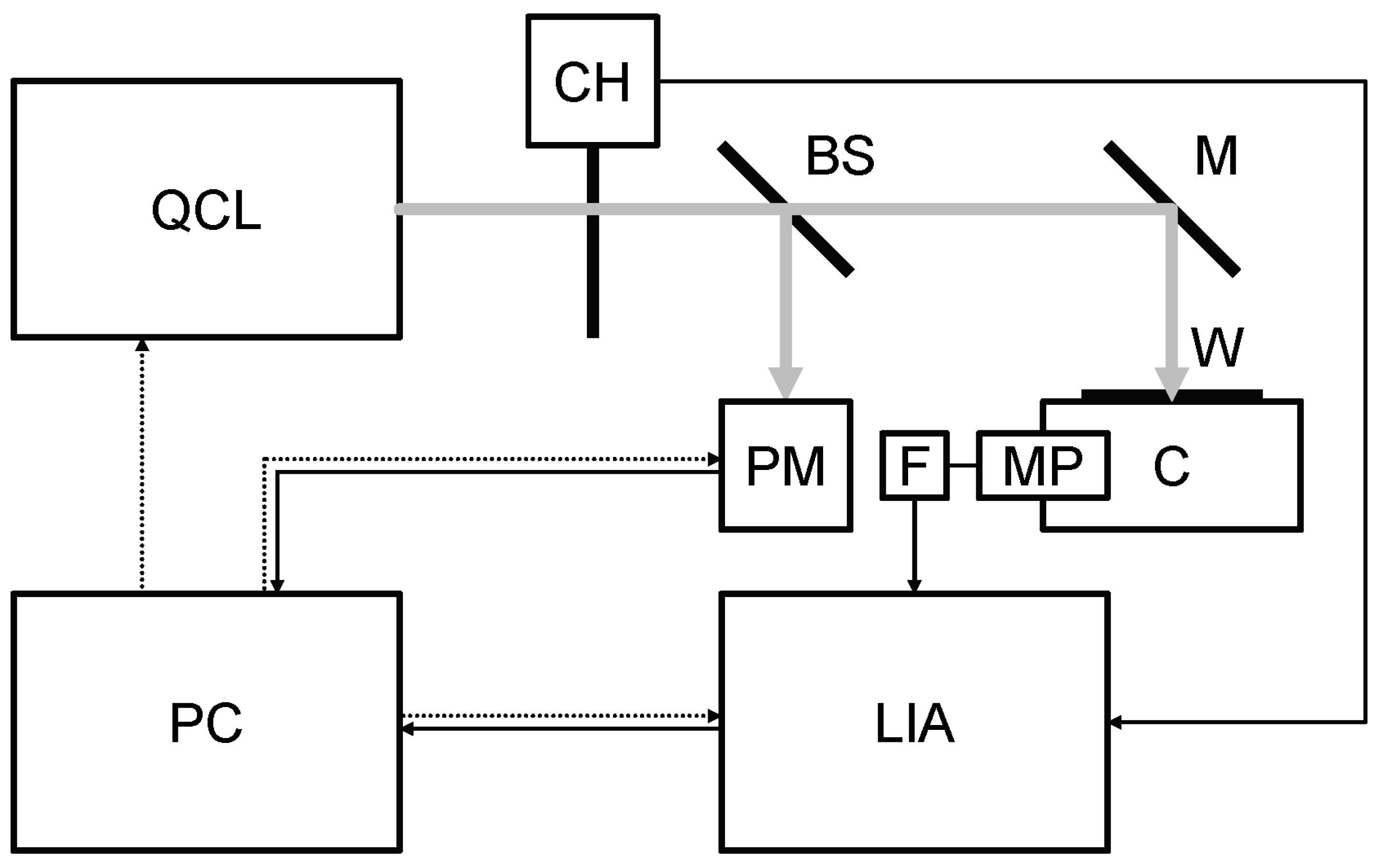
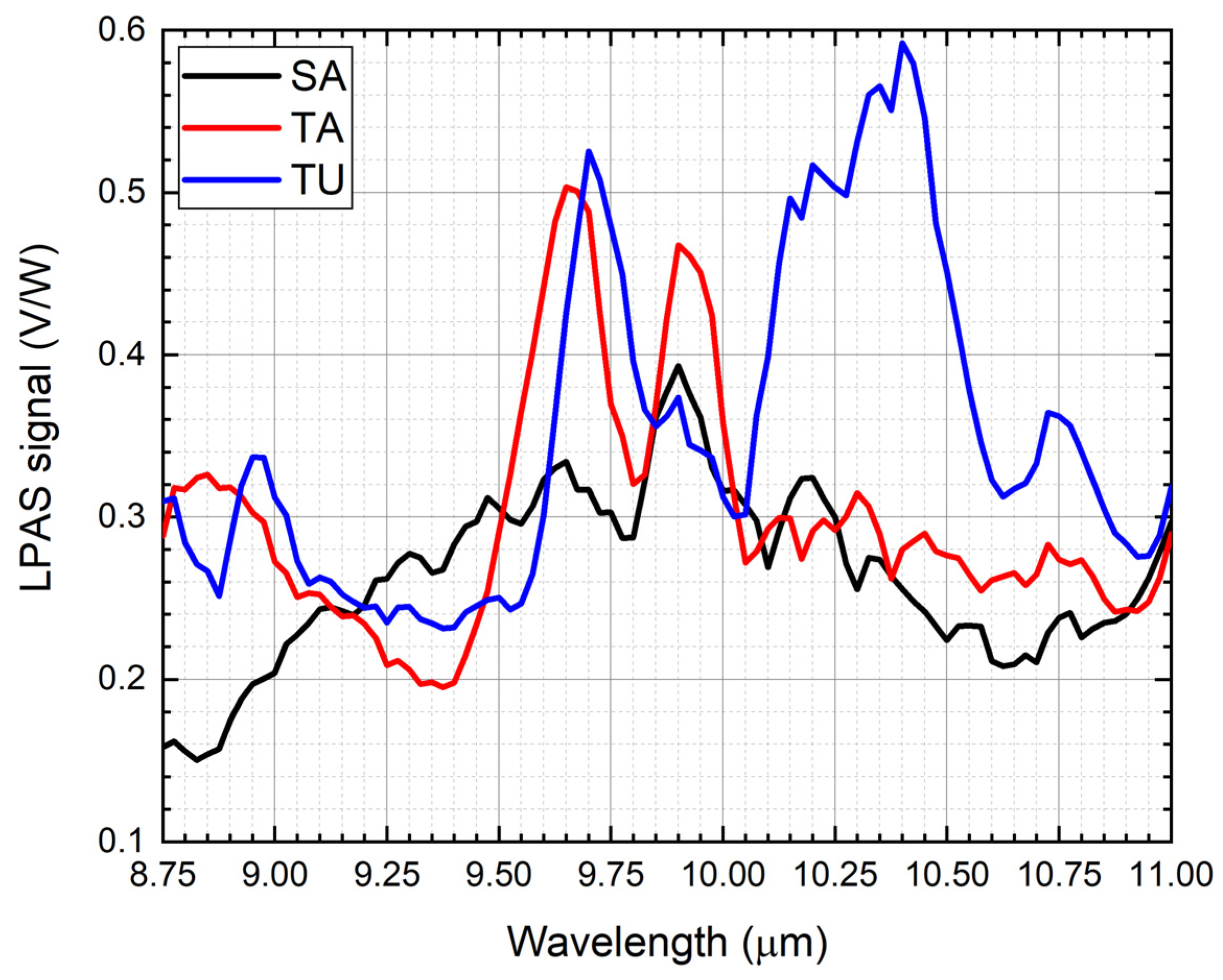
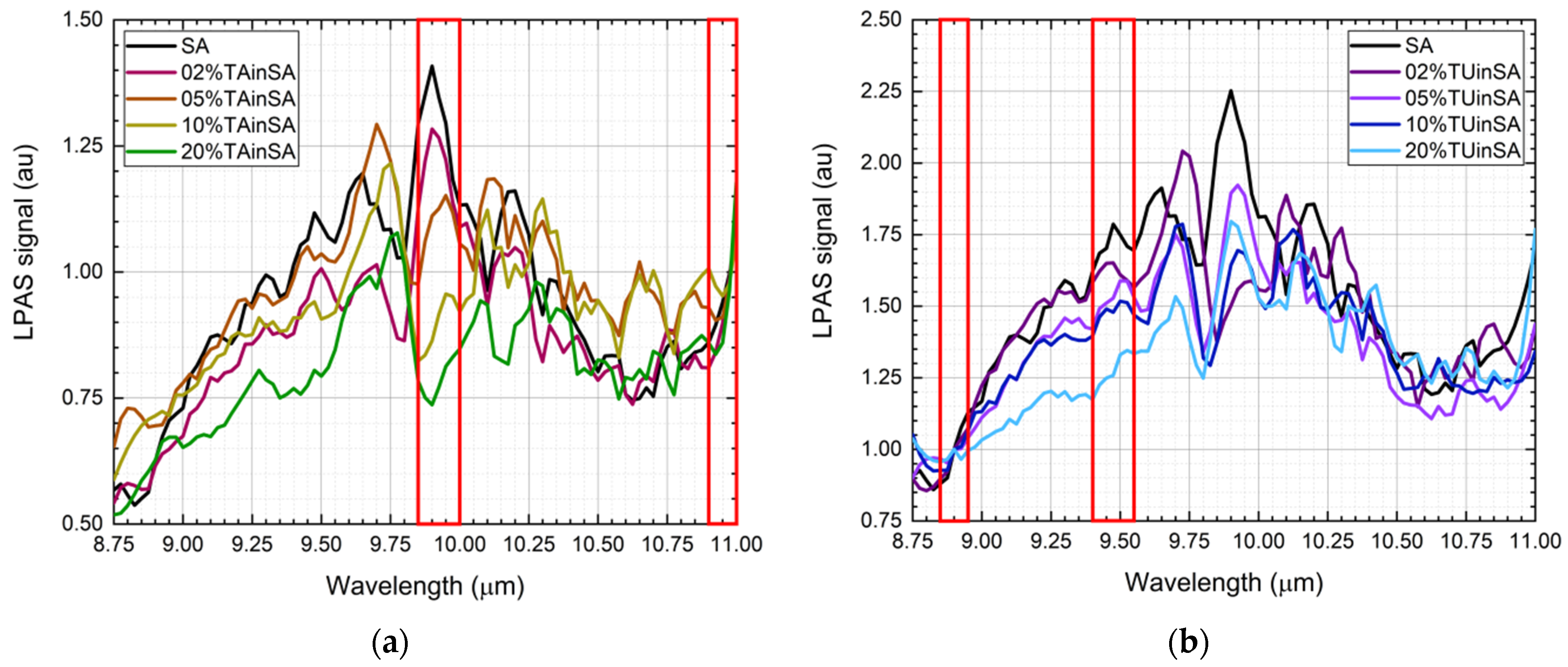
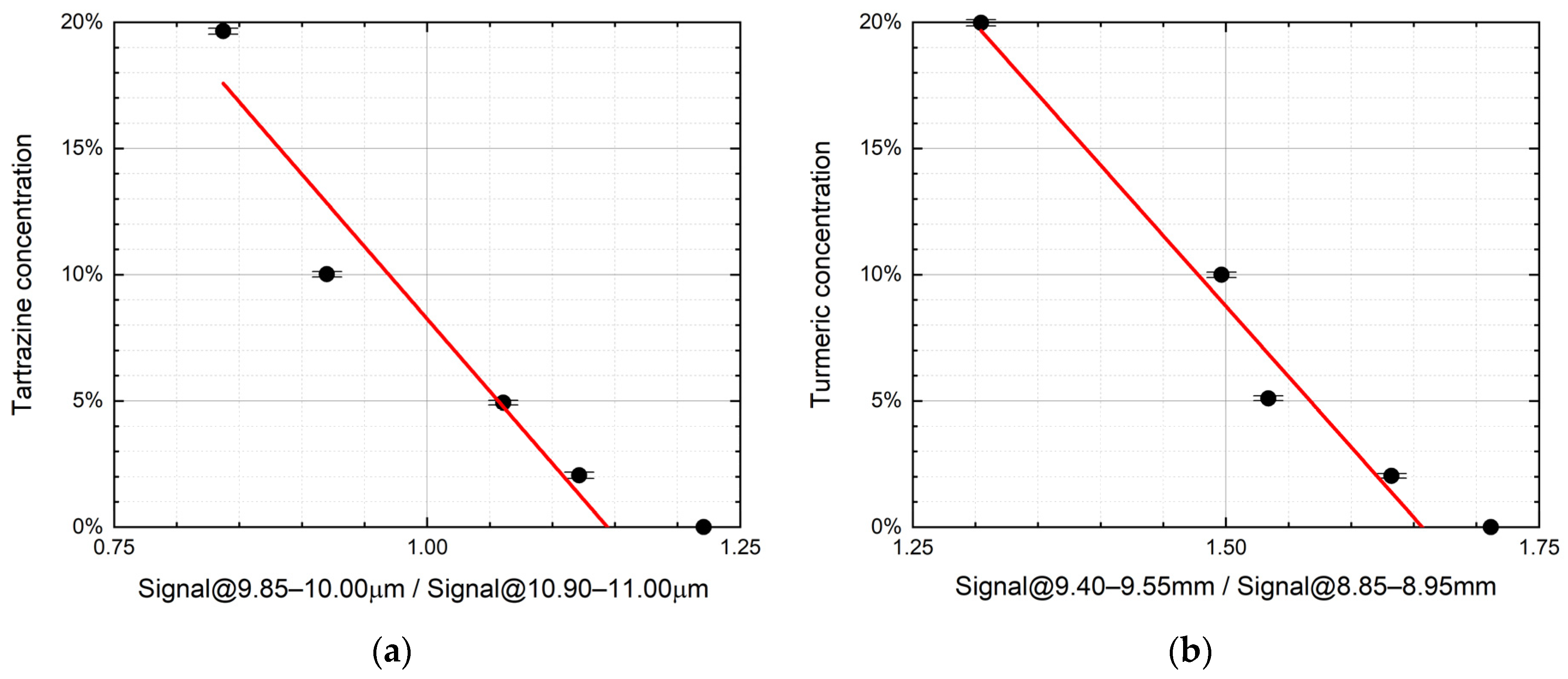
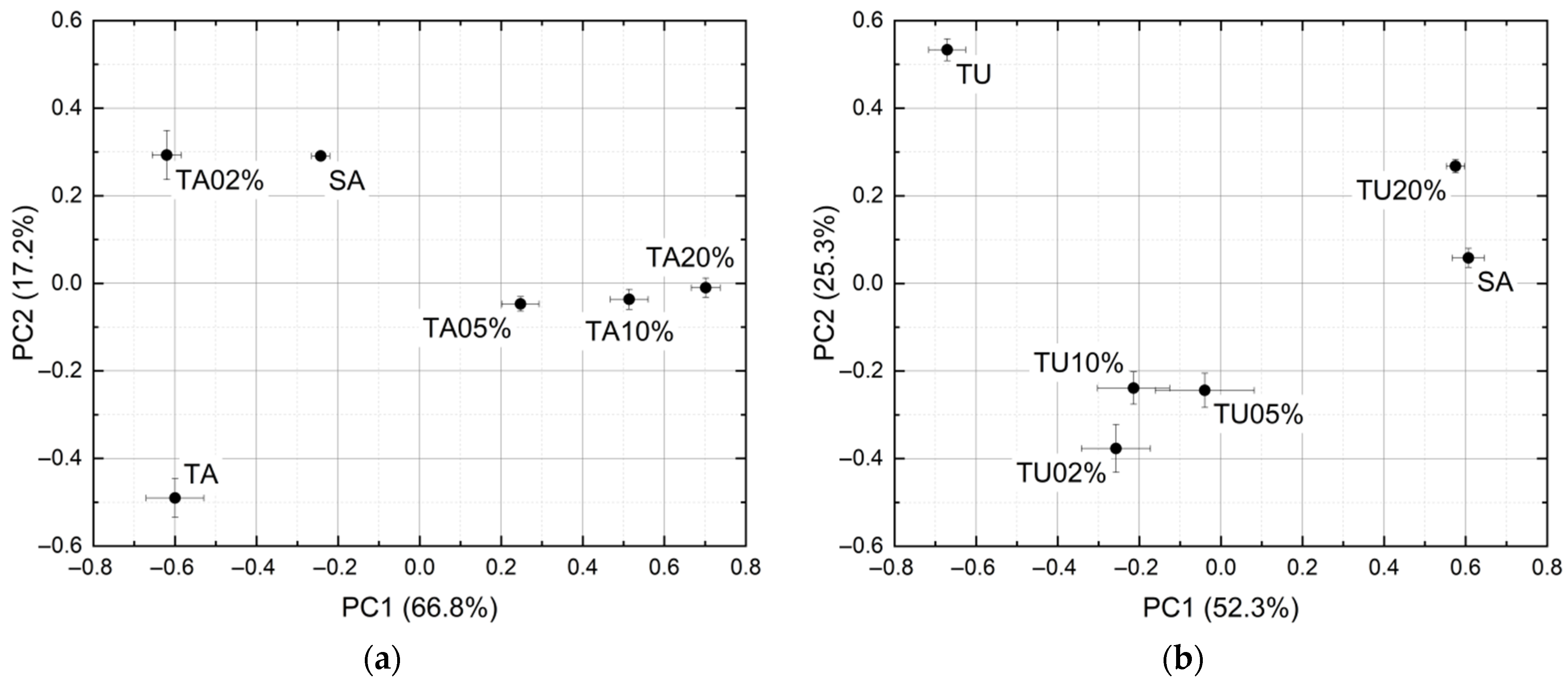
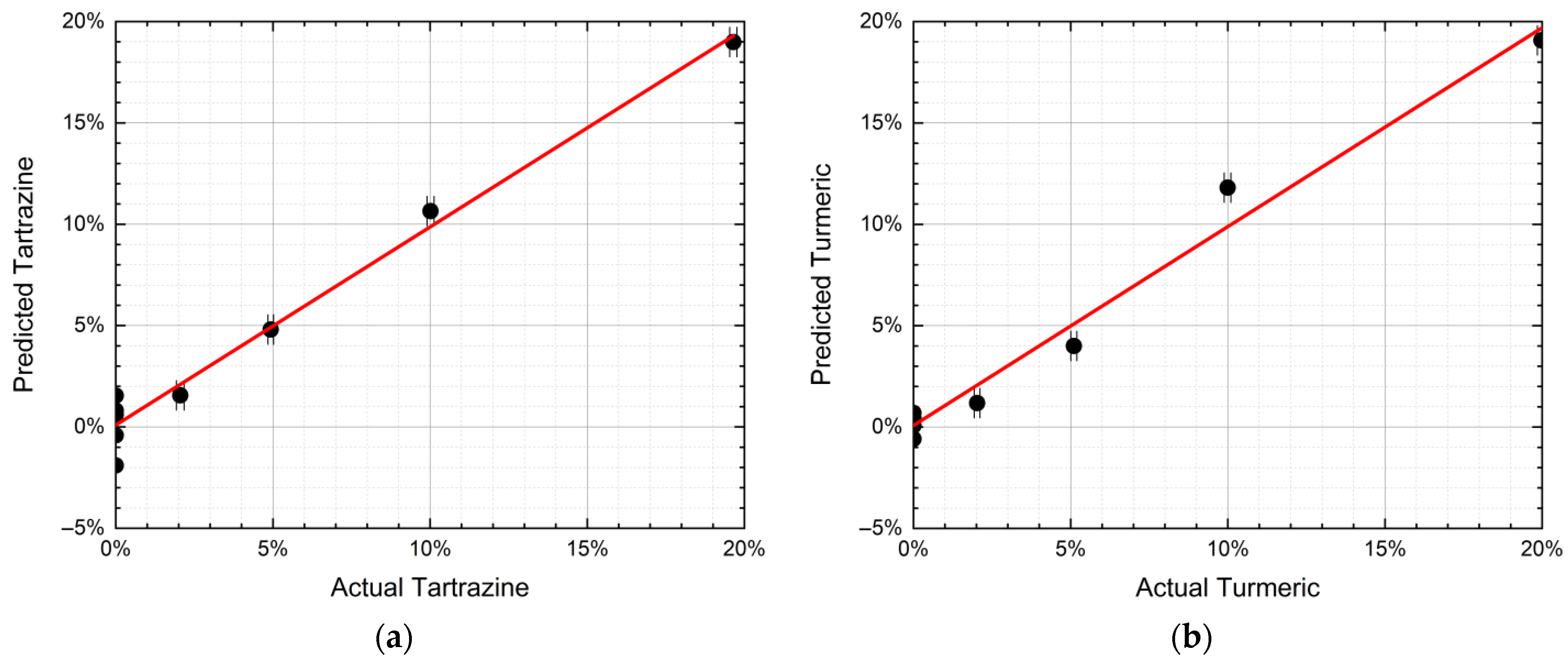
| Element | Manufacturer | Model |
|---|---|---|
| BS | Thorlabs | WG71050 |
| C | ENEA 1 | N.A. |
| CH | Stanford Research Systems | SR540 |
| F | Hewlett-Packard | 5489A |
| LIA | Stanford Research Systems | SR530 |
| M | Thorlabs | PF10-03-M02 |
| MP | Knowles | EK23024000 |
| PC | Asus | X55C |
| PM | Gentec-EO | XLP12-1S-H2-DO |
| QCL | DRS Daylight Solutions | MIRcat-1200 |
| W | Thorlabs | WG71050-E4 |
| Parameter | Value |
|---|---|
| Wavelength range | 8.33–11.11 µm |
| Linewidth | 100 MHz |
| Wavelength accuracy | 1 cm−1 |
| Average power | 60 mW |
| Power stability | 3% |
| Spatial mode | TEM00 |
| Beam divergence | 4 mrad |
| Beam pointing stability | 2 mrad |
| Spot size | 2.5 mm |
| Polarization | Vertical 100:1 |
Publisher’s Note: MDPI stays neutral with regard to jurisdictional claims in published maps and institutional affiliations. |
© 2021 by the authors. Licensee MDPI, Basel, Switzerland. This article is an open access article distributed under the terms and conditions of the Creative Commons Attribution (CC BY) license (https://creativecommons.org/licenses/by/4.0/).
Share and Cite
Fiorani, L.; Artuso, F.; Giardina, I.; Lai, A.; Mannori, S.; Puiu, A. Photoacoustic Laser System for Food Fraud Detection. Sensors 2021, 21, 4178. https://doi.org/10.3390/s21124178
Fiorani L, Artuso F, Giardina I, Lai A, Mannori S, Puiu A. Photoacoustic Laser System for Food Fraud Detection. Sensors. 2021; 21(12):4178. https://doi.org/10.3390/s21124178
Chicago/Turabian StyleFiorani, Luca, Florinda Artuso, Isabella Giardina, Antonia Lai, Simone Mannori, and Adriana Puiu. 2021. "Photoacoustic Laser System for Food Fraud Detection" Sensors 21, no. 12: 4178. https://doi.org/10.3390/s21124178
APA StyleFiorani, L., Artuso, F., Giardina, I., Lai, A., Mannori, S., & Puiu, A. (2021). Photoacoustic Laser System for Food Fraud Detection. Sensors, 21(12), 4178. https://doi.org/10.3390/s21124178








